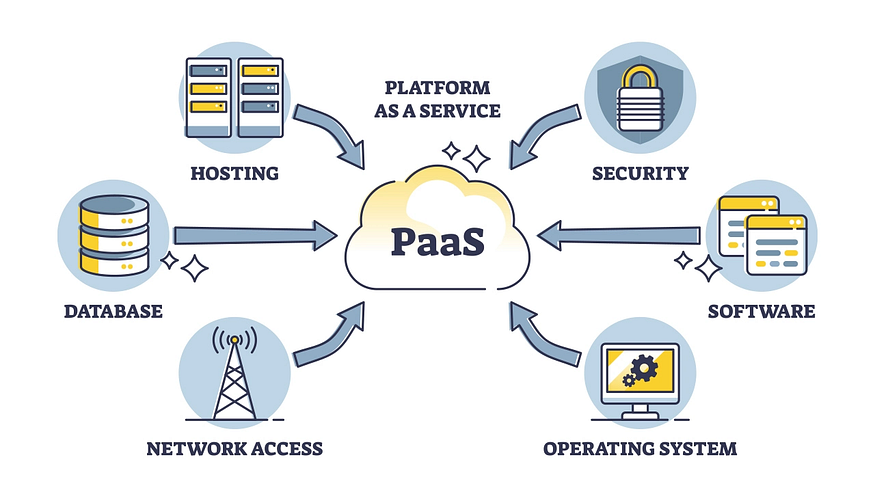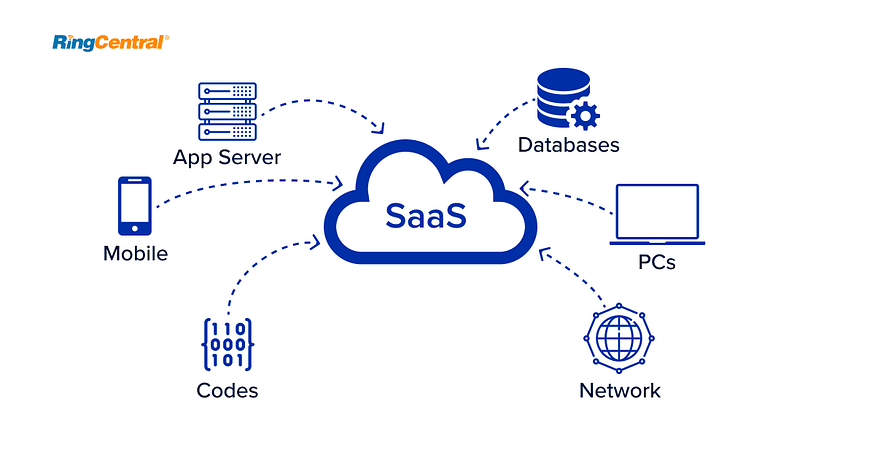Cloud Service Models - IaaS, PaaS, and SaaS
 Rishabh Gupta
Rishabh Gupta
In today’s digital landscape, cloud computing is transforming business operations with its unmatched flexibility, scalability, and efficiency. Understanding cloud service models, from IaaS and PaaS to SaaS, is essential for leveraging this power. Discover how these sophisticated models can optimize your business strategy and drive innovation.
Cloud Service Models
Cloud Service Models include Infrastructure as a Service (IaaS), Platform as a Service (PaaS), and Software as a Service (SaaS), each offering unique advantages tailored to different business needs.
1. Infrastructure as a Service (IaaS)

Infrastructure as a Service (IaaS) is one of the fundamental cloud service models that provides virtualized computing resources over the Internet. This model enables organizations to rent infrastructure components such as servers, storage, networking, and virtualization from a cloud provider, rather than purchasing and maintaining physical hardware themselves.
Components of IaaS
Compute: IaaS provides virtual servers or instances, which are the primary computing resources. Users can select the amount of CPU, memory, and storage they require for their workloads.
Storage: Cloud storage solutions offered by IaaS providers can include block storage, file storage, and object storage, each suitable for different types of data and use cases.
Networking: IaaS includes networking capabilities such as virtual private networks (VPNs), load balancers, and firewalls. These services help in creating secure and efficient network architectures within the cloud environment.
Management Tools: IaaS platforms often come with a suite of management tools for monitoring, managing, and automating infrastructure tasks. These tools can include dashboards, APIs, and command-line interfaces (CLIs).
Key Features of IaaS
Virtualization: IaaS providers use virtualization technology to deliver computing resources. This allows multiple virtual machines (VMs) to run on a single physical server, optimizing resource utilization and providing isolation between different users’ environments.
Scalability: One of the primary advantages of IaaS is its scalability. Organizations can quickly scale up or down based on their needs without investing in physical infrastructure. This is particularly useful for handling varying workloads and unexpected traffic spikes.
Cost-Effectiveness: IaaS operates on a pay-as-you-go pricing model, where businesses pay only for the resources they consume. This eliminates the need for large upfront investments in hardware and reduces ongoing operational costs related to maintenance, power, and cooling.
Flexibility: IaaS offers a high degree of flexibility, allowing businesses to choose the exact combination of computing, storage, and networking resources they need. Users can deploy, configure, and manage their applications and operating systems as they see fit.
Disaster Recovery and Backup: IaaS providers often offer robust disaster recovery and backup solutions. By leveraging multiple data centers and redundant systems, they can ensure high availability and quick recovery in case of failures.
Benefits of IaaS
Reduced Time to Market: By quickly provisioning and deploying infrastructure, businesses can accelerate the development and delivery of new products and services.
Focus on Core Business: With IaaS handling the underlying infrastructure, organizations can focus more on their core competencies and strategic initiatives rather than on IT management.
Global Reach: Leading IaaS providers have data centers across the globe, allowing businesses to deploy their applications closer to their customers, improving performance and compliance with local regulations.
Innovation and Agility: IaaS enables businesses to experiment with new technologies and scale innovative solutions rapidly, fostering a culture of agility and continuous improvement.
Platform as a Service (PaaS)

Platform as a Service (PaaS) is a cloud computing model that provides a comprehensive platform allowing developers to build, deploy, and manage applications without the complexity of managing the underlying infrastructure. PaaS supplies all the necessary resources required for application development, including servers, storage, databases, development tools, and middleware, all hosted and maintained by the cloud service provider.
Components of PaaS
Development Tools: PaaS includes tools for coding, testing, debugging, and deploying applications. These tools may be integrated into a web-based IDE or available as standalone software.
Database Management Systems: PaaS provides managed databases, including options for relational databases (SQL) and non-relational databases (NoSQL). These services handle data storage, retrieval, and management.
Application Hosting: PaaS platforms host applications and provide the necessary runtime environment. This includes web servers, application servers, and other services required to run applications.
Middleware: Middleware services offered by PaaS facilitate communication and data management between applications. This includes messaging services, application servers, and integration services.
Business Analytics: Some PaaS platforms include tools for business analytics and intelligence, allowing developers to incorporate data-driven insights into their applications.
Key Features of PaaS
Application Development Framework: PaaS provides integrated development environments (IDEs) that support coding, testing, and debugging applications. These environments often include popular programming languages, frameworks, and libraries.
Database Management: PaaS platforms offer database services that include both SQL and NoSQL options. These databases are fully managed, meaning the provider handles tasks like scaling, backups, and updates.
Middleware Services: PaaS includes middleware, which is software that connects different applications and allows them to communicate. Middleware can include web servers, application servers, and message queues.
Scalability: PaaS automatically scales resources up or down based on the application’s needs. This ensures that applications can handle varying loads efficiently without manual intervention.
Integrated Development Tools: PaaS platforms come with tools for version control, testing, integration, and deployment. These tools help streamline the development process and support continuous integration and continuous deployment (CI/CD) practices.
Security and Compliance: PaaS providers implement security measures such as encryption, access controls, and compliance certifications. This allows developers to focus on building secure applications without worrying about the underlying security infrastructure.
Benefits of PaaS
Faster Development: PaaS reduces the time required to set up and manage infrastructure, allowing developers to focus on writing code and creating applications. This accelerates the development lifecycle from ideation to deployment.
Cost-Effective: By eliminating the need to purchase and maintain hardware and software, PaaS reduces upfront costs. The pay-as-you-go model ensures that businesses only pay for what they use, optimizing costs.
Ease of Maintenance: PaaS providers handle routine infrastructure maintenance tasks such as updates, patches, and backups. This frees up internal IT teams to focus on more strategic activities.
Collaboration: PaaS environments support team collaboration by providing shared development environments and tools. This is especially beneficial for distributed teams working on the same project.
Flexibility: Developers can use a wide range of programming languages, frameworks, and tools supported by the PaaS provider. This allows them to choose the best tools for their specific application requirements.
Software as a Service (SaaS)

Software as a Service (SaaS) is a cloud computing model where software applications are delivered over the internet as a service. Instead of installing and maintaining software on individual computers or servers, users access the application through a web browser, with the software being hosted on the provider’s infrastructure. SaaS is popular for its convenience, cost-efficiency, and ability to provide seamless updates and maintenance.
Components of SaaS
Application Software: The main component is the application software itself, which is hosted on the provider’s servers and accessed via a web interface.
Middleware: Middleware in SaaS includes various services that enable the application to function smoothly, such as database management, application servers, and integration services.
Data Storage: SaaS providers offer secure data storage solutions that ensure data integrity, backup, and disaster recovery.
API and Integration: Many SaaS applications provide APIs (Application Programming Interfaces) that allow integration with other software and services, enhancing the functionality and interoperability of the application.
Support Services: SaaS providers often include customer support, training, and documentation as part of their offering to help users get the most out of the software.
Key Features of SaaS
Web-Based Access: SaaS applications are accessible via a web browser, eliminating the need for complex installations. This allows users to access the software from any device with an internet connection.
Subscription-Based Pricing: SaaS typically follows a subscription model, where users pay a recurring fee (monthly or annually) to use the software. This model often includes different pricing tiers based on the features and number of users.
Automatic Updates: The SaaS provider handles all updates and patches, ensuring that users always have access to the latest version of the software without any manual intervention.
Scalability: SaaS applications can easily scale to accommodate the needs of businesses of all sizes, from small startups to large enterprises. Providers manage the underlying infrastructure to handle increased user demand.
Multi-Tenancy: SaaS applications often use a multi-tenant architecture, where a single instance of the software serves multiple customers. This allows for efficient resource utilization and cost savings.
Data Security and Compliance: SaaS providers implement robust security measures and compliance certifications to protect user data. This includes encryption, access controls, and adherence to industry standards.
Benefits of SaaS
Reduced IT Burden: With the SaaS model, the provider manages the infrastructure, updates, and maintenance, reducing the burden on the user’s internal IT team.
Lower Costs: SaaS eliminates the need for expensive hardware, software licenses, and in-house maintenance, leading to significant cost savings. The subscription model also allows for predictable budgeting.
Easy Accessibility and Collaboration: Since SaaS applications are web-based, they enable easy access from any location and device. This fosters collaboration among remote and distributed teams.
Quick Deployment: SaaS applications can be quickly deployed and are ready to use almost immediately after purchase. This accelerates time to value for businesses.
Flexible and Scalable: SaaS solutions can be scaled up or down based on the organization’s needs, providing flexibility to adapt to changing requirements without significant investments.
Conclusion
Each cloud service model — IaaS, PaaS, and SaaS — offers distinct benefits that cater to different aspects of business operations and software development. IaaS provides the foundational infrastructure for flexible and scalable computing resources, PaaS simplifies and accelerates application development, and SaaS delivers ready-to-use software applications with ease of access and management. By understanding and leveraging these models, businesses can optimize their IT strategies, reduce costs, and drive innovation in a rapidly evolving digital landscape.
Any personal insights and/or experiences shared in the comments are greatly appreciated and encouraged!
Bravo! You’ve made it to the end. Now, before you leave:
Please consider Following the writer ✍️.
Original article on Medium - Click here.
Subscribe to my newsletter
Read articles from Rishabh Gupta directly inside your inbox. Subscribe to the newsletter, and don't miss out.
Written by
